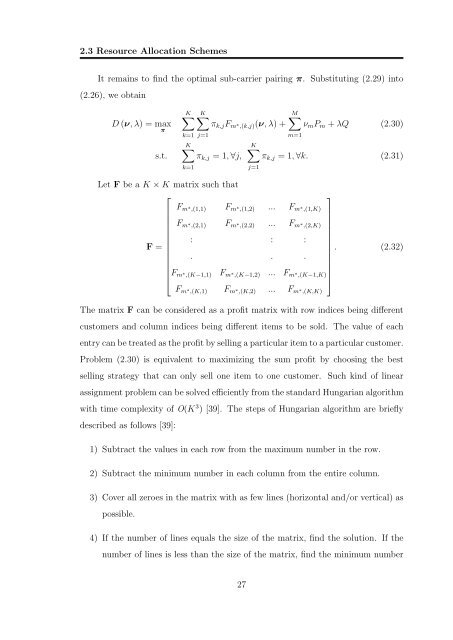Resource Allocation in OFDM Based Wireless Relay Networks ...
Resource Allocation in OFDM Based Wireless Relay Networks ...
Resource Allocation in OFDM Based Wireless Relay Networks ...
Create successful ePaper yourself
Turn your PDF publications into a flip-book with our unique Google optimized e-Paper software.
2.3 <strong>Resource</strong> <strong>Allocation</strong> Schemes<br />
It rema<strong>in</strong>s to f<strong>in</strong>d the optimal sub-carrier pair<strong>in</strong>g π. Substitut<strong>in</strong>g (2.29) <strong>in</strong>to<br />
(2.26), we obta<strong>in</strong><br />
D (ν, λ) = max<br />
π<br />
s.t.<br />
K∑ K∑<br />
M∑<br />
π k,j F m ∗ ,(k,j)(ν, λ) + ν m P m + λQ (2.30)<br />
k=1 j=1<br />
K∑<br />
π k,j = 1, ∀j,<br />
k=1<br />
j=1<br />
m=1<br />
K∑<br />
π k,j = 1, ∀k. (2.31)<br />
Let F be a K × K matrix such that<br />
⎡<br />
⎤<br />
F m ∗ ,(1,1) F m ∗ ,(1,2) ... F m ∗ ,(1,K)<br />
F m ∗ ,(2,1) F m ∗ ,(2,2) ... F m ∗ ,(2,K)<br />
: : :<br />
F =<br />
. (2.32)<br />
. . .<br />
⎢F ⎣ m ∗ ,(K−1,1) F m ∗ ,(K−1,2) ... F m ∗ ,(K−1,K) ⎥<br />
⎦<br />
F m ∗ ,(K,1) F m ∗ ,(K,2) ... F m ∗ ,(K,K)<br />
The matrix F can be considered as a profit matrix with row <strong>in</strong>dices be<strong>in</strong>g different<br />
customers and column <strong>in</strong>dices be<strong>in</strong>g different items to be sold. The value of each<br />
entry can be treated as the profit by sell<strong>in</strong>g a particular item to a particular customer.<br />
Problem (2.30) is equivalent to maximiz<strong>in</strong>g the sum profit by choos<strong>in</strong>g the best<br />
sell<strong>in</strong>g strategy that can only sell one item to one customer. Such k<strong>in</strong>d of l<strong>in</strong>ear<br />
assignment problem can be solved efficiently from the standard Hungarian algorithm<br />
with time complexity of O(K 3 ) [39]. The steps of Hungarian algorithm are briefly<br />
described as follows [39]:<br />
1) Subtract the values <strong>in</strong> each row from the maximum number <strong>in</strong> the row.<br />
2) Subtract the m<strong>in</strong>imum number <strong>in</strong> each column from the entire column.<br />
3) Cover all zeroes <strong>in</strong> the matrix with as few l<strong>in</strong>es (horizontal and/or vertical) as<br />
possible.<br />
4) If the number of l<strong>in</strong>es equals the size of the matrix, f<strong>in</strong>d the solution. If the<br />
number of l<strong>in</strong>es is less than the size of the matrix, f<strong>in</strong>d the m<strong>in</strong>imum number<br />
27

















